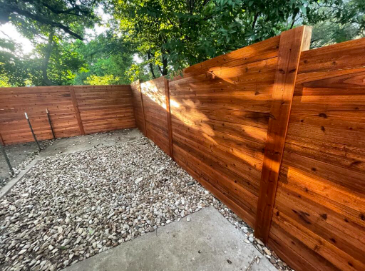
While giving the wood long-lasting protection, staining a fence will dramatically improve the look of your yard. To stop undesired damage, though, it's crucial to be aware of the plants, grass, and other places around the fence throughout the Austin fence staining process. Though good for wood, improper management of stain could damage greenery, flowers, and surrounding materials. Here's a guide to help you give your fence a fresh makeover and safeguard your plants and surrounds.
Plan and get ready before staining
Careful preparation is the first step in making sure your surrounds and plants remain secure even while you stain your fence. Start by considering how your fence's layout fits surrounding flowers, grass, trees, or garden buildings. Note which places run the danger of getting into touch with runoff, overspray, or stain drips. Create a list of every item you will need—drop cloths, painter's tape, plastic sheeting, and any equipment needed to fasten these covers—that will help to safeguard these places. Having all the supplies available helps you to lower the possibility of unintentional staining and speed up and smooth the operation.
Cover plants with plastic sheets and drop cloths
Covering surrounding surfaces or plants with drop cloths or plastic sheets is one of the best methods to guard them. Being reusable and thick enough to stop stain absorption, fabric drop cloths are a fantastic choice. Conversely, plastic sheets are lightweight and waterproof, which makes them an excellent fit for bigger regions. Drape the plastic or drop cloths gently over shrubs, flowers, or tiny plants next to the fence line. Cover the base and any limbs near the fence for bigger plants or trees.
Maintaining a Safe Distance Using Spraying Methods
You should especially be careful with the spray distance and angle control. Though they are quick and effective, fence stain sprayers can produce a fine mist that, particularly on a windy day, might drift into surrounding plants or grass. Avoid staining on windy days to reduce this risk; the wind might blow droplets further beyond the fence. Try to keep the nozzle near the fence when spraying and avoid running continuous streams; instead, use brief bursts. Work methodically, under control, concentrating on tiny fence portions at a time. This method will lower the possibility of overspray floating onto adjacent greeneries.
Shield the ground under the fence

Direct under the fence, grass and dirt are often prone to absorbing more stain drops. Cover the base of the fence with a drop cloth or plastic sheeting to guard these places. To hold the cloth or sheeting in place on sloping or uneven ground, fasten it with pebbles or posts. Underneath the drop cloth, mulch or cardboard would help to absorb any spills and simplify cleanup later on for further protection. Covering the ground helps you also stop the stain from seeping into the earth, therefore safeguarding roots and preventing over time contamination of surrounding plants.
These guidelines will help you to get a beautifully stained fence and safeguard your plants and surrounds. Spending some time to plan, cover, and keep an eye on your work area can help to greatly preserve the health and beauty of your garden and give your Austin fence staining the renewal it needs. These guidelines will enable you to finish the project safely and successfully whether your yard is tiny or large.
Related Article:



(0) comments
We welcome your comments
Log In
Post a comment as Guest
Keep it Clean. Please avoid obscene, vulgar, lewd, racist or sexually-oriented language.
PLEASE TURN OFF YOUR CAPS LOCK.
Don't Threaten. Threats of harming another person will not be tolerated.
Be Truthful. Don't knowingly lie about anyone or anything.
Be Nice. No racism, sexism or any sort of -ism that is degrading to another person.
Be Proactive. Use the 'Report' link on each comment to let us know of abusive posts.
Share with Us. We'd love to hear eyewitness accounts, the history behind an article.